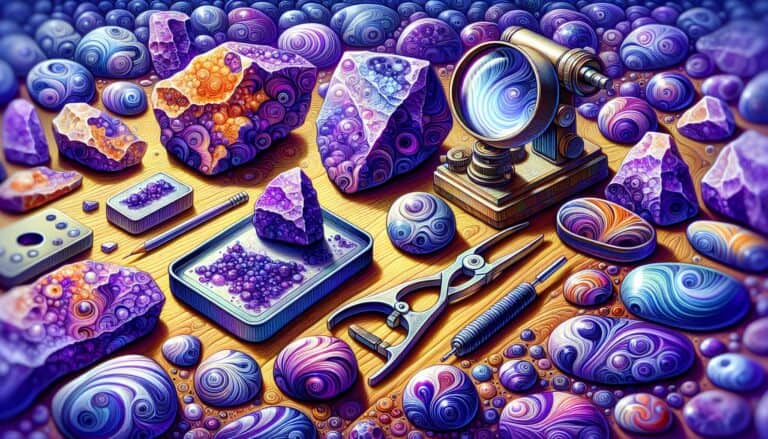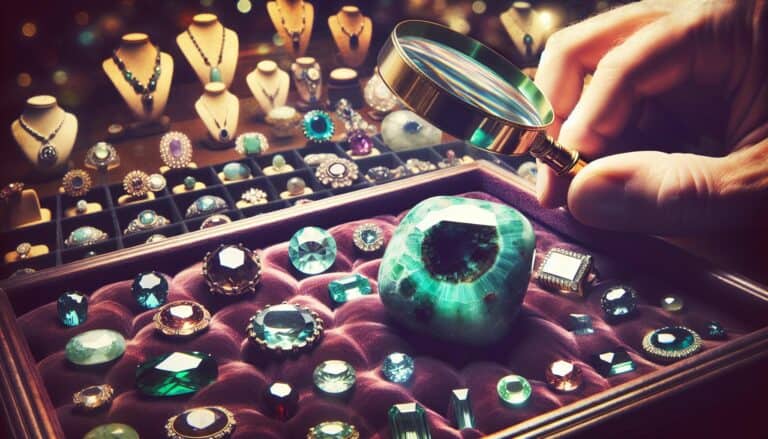Discovering the delicate charm of kunzite is like uncovering a hidden gem—literally.
You’re on a quest to identify this alluring stone, renowned for its captivating shades of pink and lilac. It’s a journey that requires a keen eye and a bit of know-how.
Don’t worry, you’re not alone. Whether you’re a budding gemstone enthusiast or a seasoned collector, understanding the nuances that make kunzite unique is key.
From its pleochroic nature to its distinct physical properties, you’ll soon be spotting kunzite with confidence.
Spot kunzite: pink/lilac, streak test (white), magnet test (non-magnetic), hardness test (6.5-7), birefringence. Look for elongated crystals in pegmatites. Prepare with tools, prioritize safety. Clean gently, store in soft cloth. Enjoy unique beauty!
How to Identify Kunzite Through Testing
When you’ve got your hands on a potential kunzite, it’s crucial to confirm its identity through specific testing. Here’s how you can do just that.
Visual Inspection
Begin by looking closely at the gemstone. Kunzite typically shows hues of pink to lilac. Remember, it’s also pleochroic, which means it shows different colors when viewed at different angles. Look for its signature colors and note any changes as you tilt the stone.
The Streak Test
Drag the stone across an unglazed porcelain tile to check its streak color. A kunzite should leave a white streak.
Magnet Test
Kunzite isn’t magnetic, so if your stone is attracted to a magnet, chances are it’s not genuine kunzite.
Hardness Test
Use a scratch test to determine its hardness. Kunzite ranks at about 6.5 to 7 on the Mohs scale. It should be able to scratch glass but not as easily as harder minerals like quartz.
Birefringence Test
Kunzite displays birefringence, which is the splitting of a light ray into two paths when it passes through the stone. Check this with a loupe—if you see two images of the pavilion facets’ back edge, that’s proof of birefringence.
Checking The Diaphaneity
Kunzite’s diaphaneity varies from transparent to translucent. Observe how light passes through the stone to get an idea of its clarity and quality.
Single or Double Refraction
Verify whether the gem shows single or double refraction. Kunzite should exhibit single refraction, as it’s from the spodumene family.
Refractive Index Test
For a more technical assessment, measure the refractive index (RI). The RI of kunzite falls between 1.660 and 1.676. This test requires special equipment like a refractometer.
Finding The Specific Gravity
Determine the specific gravity (SG) of kunzite, which is generally around 3.18. This will require specific instruments and liquids to test the stone’s buoyancy.
Identifying Kunzites in the Field
If you’re out in nature, note that raw kunzite often forms in granite pegmatites. Look for elongated, prismatic crystals with a vitreous luster.
Recognizing Potential Kunzite Rocks
In their natural habitat, potential kunzite rocks may show hints of pink through the dirt and debris. Keep an eye out for those telltale flashes of color among the rocks.
Armed with this knowledge, you’ll be ready to hone your kunzite identification skills, whether you’re assessing a polished gem or hunting for treasure in the wild. Just remember that practice makes perfect, and the more stones you test, the sharper your gemstone identification abilities will become.
Physical Characteristics of Kunzite

When setting out to identify kunzite, it’s essential to familiarize yourself with its physical characteristics. Kunzite is renowned for its delicate pink to violet hues, a feature that makes this gemstone highly sought after. Color variations are mainly due to varying amounts of manganese within the crystal structure, which can range from pale to rich pink. Over time and with exposure to sunlight, kunzite can fade; this is something to keep in mind as you evaluate specimens.
In terms of luster, kunzite possesses a glassy, vitreous sheen that contributes to its visual allure. The gemstone’s transparency can range from transparent to nearly opaque, affecting how it interacts with light and displays its intrinsic beauty. Crystal forms are usually long and striated, a reflection of kunzite’s monoclinic crystal system.
Another quintessential trait is its pleochroism — kunzite can show different colors or depths of color when viewed from different angles. This property is not only fascinating but also helps in distinguishing it from other minerals. When identifying kunzite by its physical attributes, also pay attention to its cleavage, which is perfect in one direction and can make the gemstone particularly fragile if not handled with care.
- Color: Pink to violet
- Luster: Vitreous
- Transparency: Transparent to opaque
- Crystal System: Monoclinic
- Pleochroism: Present
- Cleavage: Perfect in one direction
By carefully examining these physical characteristics and using the testing methods previously described, you’ll be well on your way to effectively identifying kunzite in a variety of settings. Remember, practice is key in mastering the skill of kunzite identification.
How Are Kunzite Formed?
Understanding kunzite’s formation is pivotal to recognizing its distinguishing characteristics. Kunzite, a variety of the mineral spodumene, forms under specific geological conditions. It requires environments rich in rare elements, typically in pegmatite veins, which are known to host large crystal formations. Pegmatites themselves form during the final stages of magma crystallization, where water-rich magma cools slowly, allowing for significant crystal growth.
Key factors involved in kunzite formation include:
- High concentrations of lithium: This element is crucial for the mineral to form its characteristic composition.
- Prolonged cooling periods: These enable the crystals to develop substantial size and clarity.
- Pressure and temperature: Optimal ranges of both contribute to the formation of well-structured kunzite crystals.
The vibrant hues of kunzite largely come from trace amounts of manganese, which can lead to colors ranging from pink to violet. Additionally, exposure to natural irradiation from the surrounding rocks can enhance the color intensity.
When searching for kunzite in the wild, it’s often found in regions with historic geological activity. Here’s where you might find deposits:
- Brazil
- Afghanistan
- Madagascar
- The United States, particularly California and Connecticut
Mining kunzite requires careful techniques to prevent damage to the crystals which are often many meters long. After extraction, kunzite’s pleochroism—displaying different colors when viewed at different angles—makes it a fascinating study for gemologists and a coveted prize for mineral collectors.
Preparation for Kunzite Hunting
Gathering the Right Tools
When embarking on your kunzite hunting adventure, having the right tools is pivotal. Begin by assembling a geologist’s hammer for chipping away rock to expose hidden kunzite. Don’t forget a durable pair of gloves to protect your hands from sharp edges and rugged terrain. A hand lens or jeweler’s loupe is equally essential, allowing you to examine potential finds with enhanced precision.
Ensure you’ve got enough packing materials to safely transport any kunzite specimens. Foam wraps and sturdy containers will safeguard your treasures from accidental damage during transit. Remember to bring a field guide on minerals which can be an invaluable reference to distinguish kunzite from similar-looking stones in real-time situations.
Here’s a concise list of hunting essentials:
- Geologist’s hammer
- Durable gloves
- Hand lens or jeweler’s loupe
- Packing materials (foam wraps, containers)
- Field guide on minerals
Safety Considerations
Your safety should always be the top priority. Before you set out, familiarize yourself with the terrain and potential hazards of the kunzite hunting site. Make sure to wear appropriate clothing, including a sturdy pair of boots to navigate the often rocky and uneven ground.
Equipping yourself with a first aid kit is a wise precaution against any unexpected injuries. Stay hydrated by carrying enough water, and be mindful of weather changes by packing additional layers or rain gear.
Inform someone about your plans, including the specific locations you’ll be exploring. In case of emergency, this information could be crucial for your swift rescue. Lastly, familiarize yourself with basic survival skills, especially if you’re venturing into remote areas where help may not be readily available.
- Understand the local terrain and hazards
- Wear proper clothing and boots
- Pack a first aid kit
- Carry sufficient water and weather-appropriate gear
- Inform someone of your location
- Learn basic survival skills
Handling and Care of Found Kunzite

When you’ve successfully identified and collected kunzite specimens, the next critical steps are proper cleaning and storing. These practices not only enhance the appearance of your kunzites but also ensure their preservation over time.
Cleaning Kunzite
Initially, you may want to gently wash the surface dirt off your kunzite with mild soap and lukewarm water. Use a soft cloth or brush to avoid scratching the stone. It’s also important to note that kunzite can fade if exposed to prolonged direct sunlight, so it’s best to clean it away from strong light sources.
For deeper cleaning, ultrasonic or steam cleaners are not recommended as kunzite is sensitive to sudden temperature changes and pressure. A safer option would be to soak the stone in warm, soapy water for a short period before rinsing it with clean water.
Storing Kunzites
After cleaning, dry your kunzite thoroughly before storage. Wrap the stone in a soft cloth or place it in a fabric-lined jewelry box to prevent any potential impact damage. For collectors, individually compartmentalized cases or display boxes can showcase the beauty of each piece while safeguarding them from scratches and dust.
It’s crucial to avoid storing kunzite in direct sunlight or high-temperature areas as this could cause color fading or fractures within the stone. Always ensure your storage area maintains a consistent, moderate temperature and is free from humidity, which can also damage your kunzite over time.
Remember, handling your kunzite with care and storing it properly will keep your specimens in pristine condition, allowing you to enjoy their unique beauty and characteristics for years to come.
Conclusion: Confirming Kunzite is Real
You’re now equipped with the essential know-how to identify and care for kunzite.
Remember, successful identification hinges on careful observation and methodical testing. Whether you’re in the field or examining a potential find, rely on your tools and knowledge to make accurate assessments. Don’t forget the importance of proper handling and storage to maintain your kunzite’s luster and prevent damage. With these tips in your arsenal, you’re ready to embark on your kunzite hunting adventure with confidence.
Happy hunting and treasure your finds!






![MA Rockhounding Sites in [year]: Treasures & Gems](https://observationhobbies.com/wp-content/uploads/2024/01/XlBh-sAkYTQF12kM8lg5Z-768x439.jpg)
